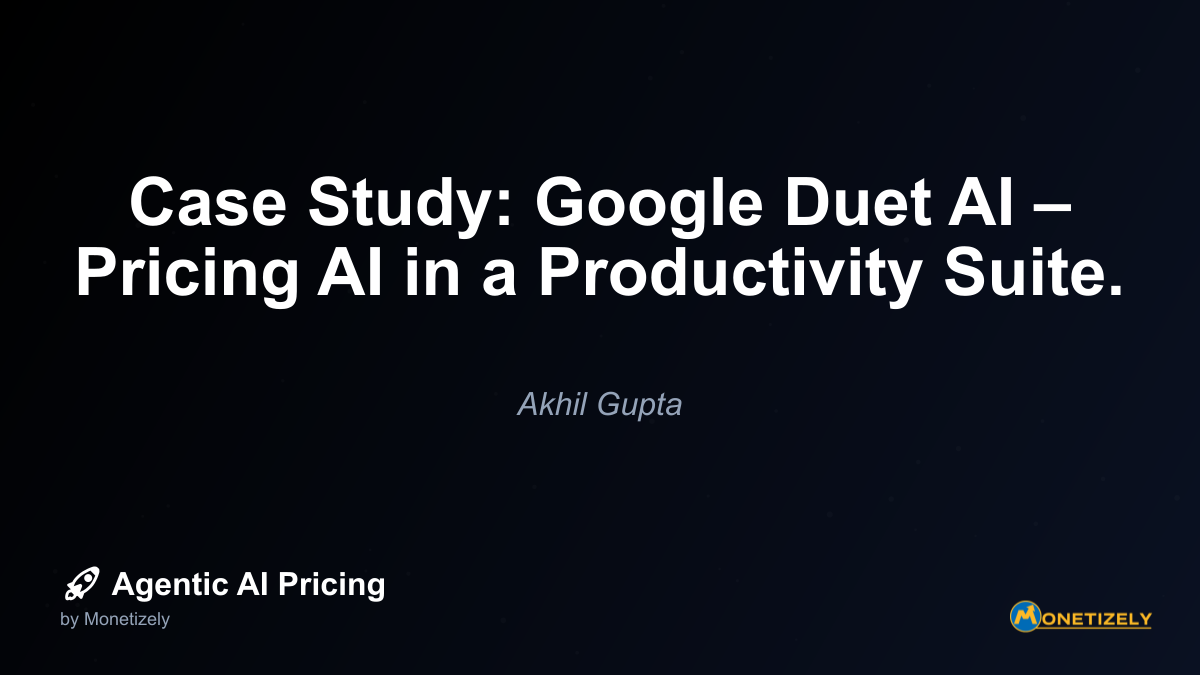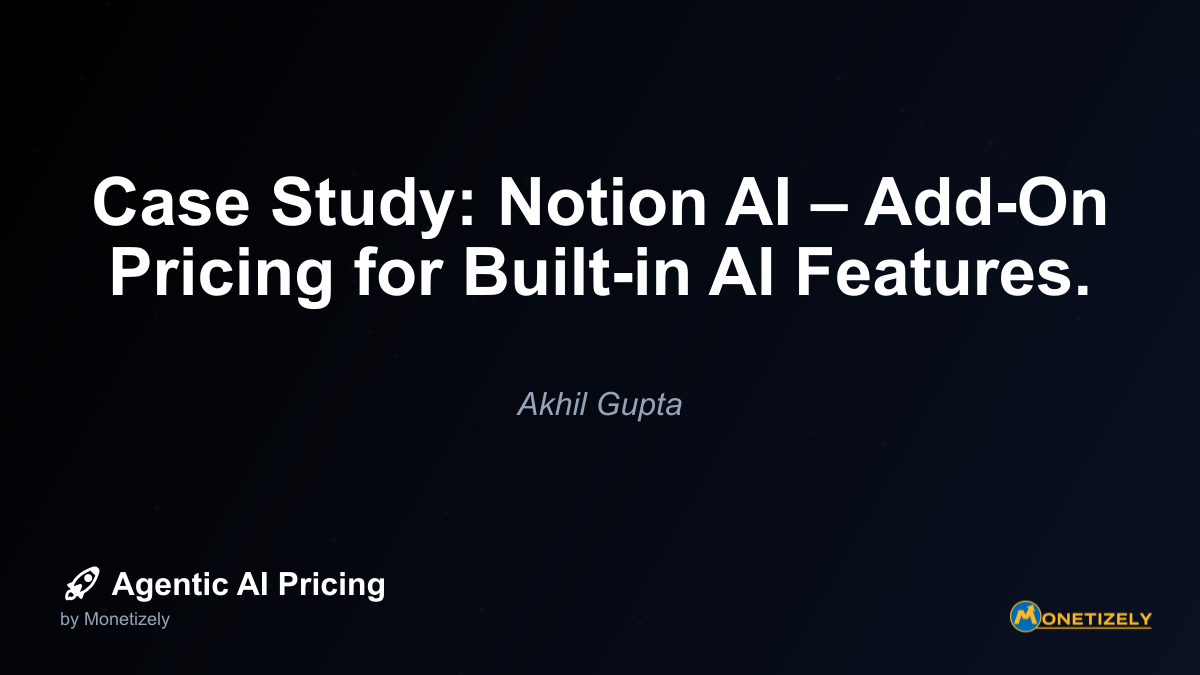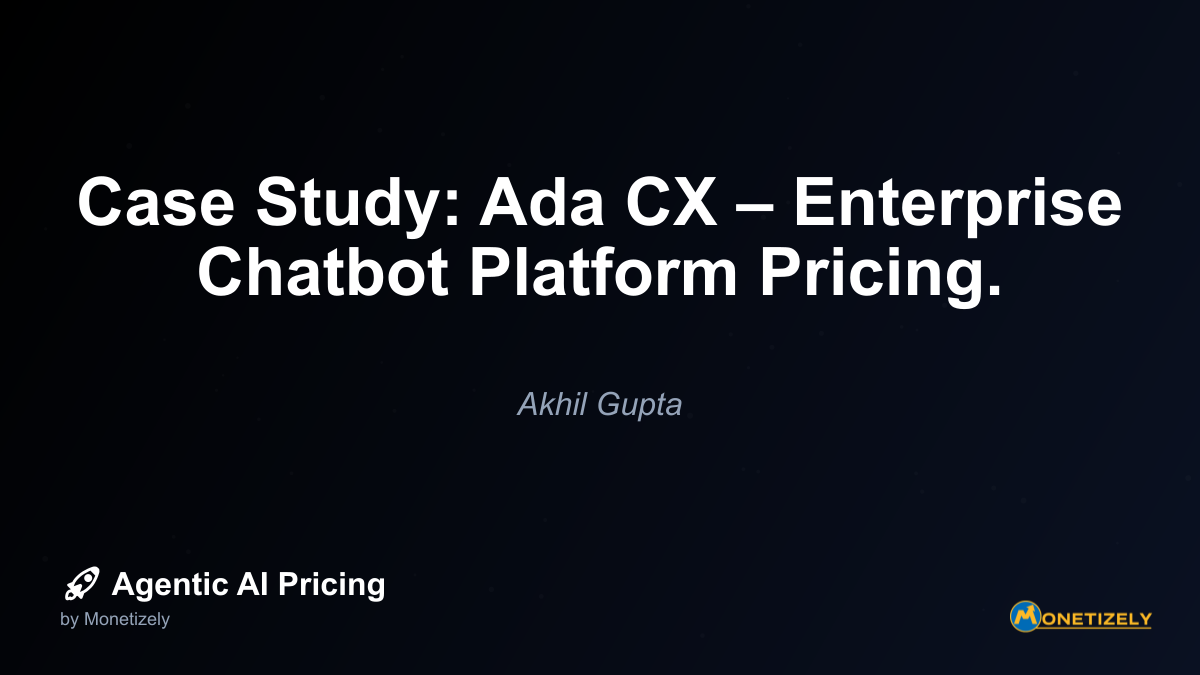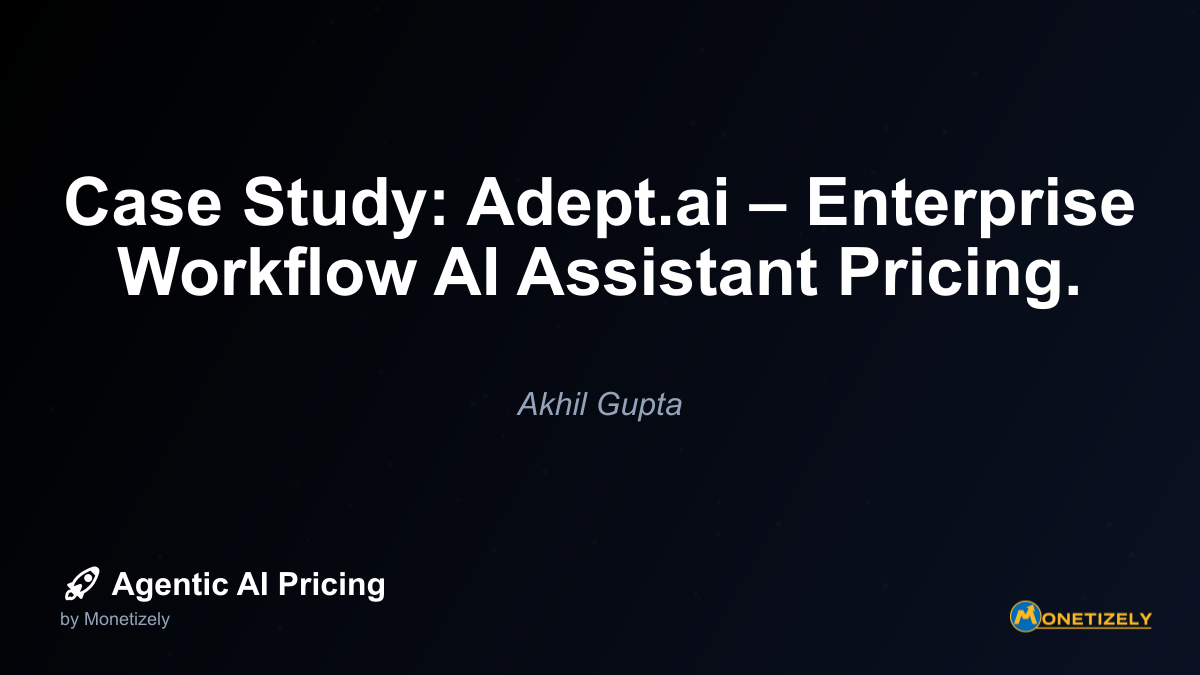· Akhil Gupta · Case Studies · 8 min read
Case Study: Google Duet AI – Pricing AI in a Productivity Suite.
AI and SaaS Pricing Masterclass
Learn the art of strategic pricing directly from industry experts. Our comprehensive course provides frameworks and methodologies for optimizing your pricing strategy in the evolving AI landscape. Earn a professional certification that can be imported directly to your LinkedIn profile.

Google’s Duet AI pricing strategy cannot be analyzed in isolation—it exists within a competitive landscape dominated by Microsoft’s similar offering, Copilot for Microsoft 365. The pricing approaches of these two tech giants reveal much about how established software providers view AI monetization.
Duet AI vs. Microsoft Copilot: Pricing Comparison
Both Google and Microsoft adopted remarkably similar pricing strategies:
- Microsoft Copilot: $30 per user per month (requires Microsoft 365 subscription)
- Google Duet AI: $30 per user per month (requires Google Workspace subscription)
This identical price point is unlikely to be coincidental and suggests several possibilities:
- Both companies conducted similar value analyses and independently arrived at the same optimal price point
- The $30 figure represents a psychological threshold for enterprise customers considering AI add-ons
- Neither company wanted to position their AI assistant as inferior by pricing it lower
- Market research indicated this price level optimizes adoption while signaling premium value
For more detailed analysis on Microsoft’s approach, see How Does Microsoft’s Copilot Pricing Strategy Reveal the Future of AI Monetization?
Strategic Implications of the Pricing Alignment
The identical pricing creates interesting market dynamics:
- Feature competition over price competition: With pricing neutralized, both companies must compete on AI capabilities and integration quality
- Market education efficiency: Both companies effectively share the burden of establishing market expectations around AI assistant pricing
- Signaling premium value: The consistent pricing helps establish AI assistants as substantial value-adds rather than minor feature enhancements
- Creating a new price tier: Both companies are establishing a new pricing level above their standard productivity suites but below specialized enterprise software
Implementation Requirements and Bundling Strategy
Google’s rollout of Duet AI revealed important aspects of its bundling and implementation approach that influence the pricing model’s effectiveness.
Technical Requirements and Dependencies
Duet AI’s implementation strategy includes several key dependencies:
- Existing Google Workspace subscription: Organizations must already be Workspace customers
- Admin-level deployment: IT administrators must enable and configure Duet AI across the organization
- User permissions management: Organizations need to determine which users receive Duet AI access
- Data privacy configurations: Admins must set appropriate data handling policies for AI interactions
These requirements reinforce the add-on nature of the pricing model while creating natural upsell opportunities within Google’s ecosystem.
Partial vs. Complete Deployment Options
Google’s pricing approach offers flexibility in how organizations deploy Duet AI:
- Organizations can choose to deploy Duet AI to only specific departments or teams
- Different user groups can receive access based on productivity needs and ROI potential
- Staged rollouts allow for gradual adoption and budget management
This deployment flexibility helps address potential customer objections to the per-user price point by allowing targeted implementation where value is most clearly demonstrated.
Lessons from Google’s Pricing Approach for AI Product Leaders
Google’s Duet AI pricing strategy offers several valuable lessons for product and pricing leaders developing AI solutions:
1. Leveraging Existing Distribution Channels
Google’s approach demonstrates the power of embedding AI capabilities within established products rather than creating standalone offerings. This strategy:
- Reduces customer acquisition costs dramatically
- Leverages existing trust and relationships
- Simplifies procurement processes
- Creates natural upsell opportunities
For AI product leaders, this suggests considering partnership or integration strategies that tap into existing customer bases rather than building entirely new distribution channels.
2. Value-Based Pricing Over Cost-Plus
Google’s $30 per user per month price point is clearly not based on the marginal cost of providing AI services. Instead, it reflects the perceived value these capabilities deliver. This value-based approach:
- Establishes AI as a premium capability worth significant investment
- Avoids commoditization of AI features
- Creates sustainable margins to fund ongoing AI development
- Positions AI as a business transformation tool rather than a utility
AI product leaders should focus pricing strategies on the business outcomes their solutions enable rather than the underlying technology costs.
3. Simplicity in Pricing Structure
Despite the complexity of the underlying AI technology, Google maintained a straightforward pricing model that customers could easily understand. This simplicity:
- Reduces friction in the purchasing decision
- Simplifies budgeting and procurement processes
- Makes ROI calculations more transparent
- Aligns with familiar SaaS purchasing patterns
AI product leaders should resist the temptation to create complex pricing models that reflect the technical sophistication of their solutions, instead focusing on clarity and alignment with established purchasing patterns.
4. Competitive Positioning Considerations
Google’s identical pricing to Microsoft’s Copilot demonstrates the importance of competitive positioning in AI pricing. This approach:
- Avoids direct price competition in early market stages
- Shifts focus to capabilities and integration quality
- Establishes market norms for AI assistant pricing
- Creates a unified signal about the value of AI productivity tools
AI product leaders should carefully consider how their pricing positions their offerings relative to competitors, particularly when establishing new product categories.
Challenges and Limitations of Google’s Approach
While Google’s pricing strategy for Duet AI offers valuable insights, it also reveals several challenges inherent in this approach:
Justifying the Premium Price Point
The $30 per user per month add-on represents a significant premium over the base Workspace subscription costs. For example:
- Google Workspace Business Standard: $12 per user per month
- Duet AI add-on: $30 per user per month
- Total cost with Duet AI: $42 per user per month (250% increase)
This substantial price increase creates several challenges:
- Proving ROI: Organizations need clear evidence that Duet AI delivers sufficient productivity gains to justify the cost increase
- Overcoming budget constraints: Many organizations have fixed productivity software budgets that may not accommodate such significant increases
- Managing internal expectations: Users may have unrealistic expectations about AI capabilities given the premium price
- Competitive alternatives: Standalone AI tools may offer similar capabilities at lower price points
Addressing Varying Value Across User Types
The uniform per-user pricing model assumes relatively consistent value delivery across different user types and roles. However, the actual value of Duet AI likely varies significantly based on:
- Job function and content creation requirements
- Technical proficiency and adaptation capabilities
- Workflow integration patterns
- Industry-specific use cases
This value variation creates potential inefficiencies in the pricing model, where some users may receive substantial ROI while others struggle to justify the cost.
Managing Feature Evolution and Value Perception
As with any AI product, Duet AI will continue to evolve with new capabilities and improvements. This ongoing evolution creates challenges for the fixed pricing model:
- Feature expectation management: Customers paying premium prices expect continuous improvement
- Value communication for incremental changes: Small improvements may not be perceived as justifying the ongoing premium
- Competitive feature parity: Maintaining differentiation as competitors enhance their AI capabilities
- Avoiding feature bloat: Adding capabilities that maintain perceived value without overwhelming users
Future Evolution of Google’s AI Pricing Strategy
Based on patterns observed in similar markets, we can anticipate several potential evolutions in Google’s approach to monetizing Duet AI:
Tiered AI Capability Levels
Google may eventually introduce multiple tiers of AI capabilities at different price points:
- Basic AI features included in standard Workspace plans
- Advanced AI capabilities at the current premium price point
- Specialized AI solutions for specific industries or use cases at higher price points
This tiered approach would allow Google to capture value across different customer segments while creating natural upgrade paths.
Consumption-Based Elements
While the core per-user model is likely to remain, Google may introduce consumption-based elements for certain high-cost AI features:
- Image generation credits or limits
- API access for custom AI integrations
- Advanced data processing capabilities
- Large-scale content generation features
These consumption elements would allow Google to maintain margins on resource-intensive features while preserving the simplicity of the core pricing model.
Industry-Specific Solutions
As Duet AI matures, Google may develop and separately price industry-specific AI capabilities:
- Legal document analysis and generation
- Healthcare documentation assistance
- Financial analysis and reporting
- Educational content creation and assessment
These specialized capabilities could command higher prices based on their specific value to target industries.
Implementation Best Practices for Organizations
For organizations considering Google’s Duet AI, several implementation best practices can help maximize ROI and justify the premium pricing:
Phased Rollout Strategy
Rather than deploying Duet AI across all users simultaneously, organizations should consider:
- Pilot programs with select teams to measure actual productivity impacts
- ROI analysis based on initial deployments to justify broader implementation
- Targeted rollouts to user groups with the clearest productivity enhancement potential
- Training and adoption programs to ensure users extract maximum value
Use Case Prioritization
Organizations should identify and prioritize the highest-value use cases for Duet AI:
- Content creation and editing workflows
- Data analysis and visualization processes
- Meeting productivity enhancements
- Email management and communication efficiencies
By focusing on these high-value areas first, organizations can build compelling ROI narratives to support broader adoption.
Integration with Existing Workflows
To maximize value realization, organizations should:
- Map existing productivity bottlenecks to specific Duet AI capabilities
- Create standardized processes that incorporate AI assistance
- Develop training materials specific to the organization’s use cases
- Establish feedback mechanisms to identify adoption challenges
Measurement and Optimization
To justify the ongoing premium cost, organizations should implement measurement frameworks:
- Time savings per user by application and task type
- Quality improvements in content and analysis outputs
- User satisfaction and adoption metrics
- Workflow efficiency gains
These measurements provide the foundation for ongoing optimization and ROI validation.
Conclusion: The Strategic Significance of Google’s Approach
Google’s pricing strategy for Duet AI represents more than just a monetization approach for a single product—it signals a fundamental shift in how AI capabilities will be valued and monetized across the software industry.
The per-user add-on model establishes AI as a premium capability worthy of significant additional investment rather than just another feature enhancement. This positioning helps set market expectations about the value of AI assistance while creating sustainable economics for ongoing AI development.
For business leaders, Google’s approach offers important strategic considerations:
- AI is being positioned as a transformative capability worth substantial investment
- Major platforms are creating new price tiers specifically for AI functionality
- The market is converging on similar pricing models, suggesting some stability in expectations
- Value-based pricing is dominating over cost-plus or usage-based models in productivity AI
As AI capabilities continue to evolve, Google’s pricing approach for Duet AI will likely serve as an influential reference point for how enterprise software providers monetize artificial intelligence. The success or failure of this model will shape AI pricing strategies across the industry for years to come.
Organizations evaluating Duet AI should look beyond the immediate price point to consider the broader productivity transformation potential these capabilities represent. While the premium cost requires careful ROI justification, the strategic advantages of enhanced AI-powered productivity may deliver value that extends well beyond the per-user price.
Co-Founder & COO
Akhil is an Engineering leader with over 16+ years of experience in building, managing and scaling web-scale, high throughput enterprise applications and teams. He has worked with and led technology teams at FabAlley, BuildSupply and Healthians. He is a graduate from Delhi College of Engineering and UC Berkeley certified CTO.
Pricing Strategy Audit
Let our experts analyze your current pricing strategy and identify opportunities for improvement. Our data-driven assessment will help you unlock untapped revenue potential and optimize your AI pricing approach.




